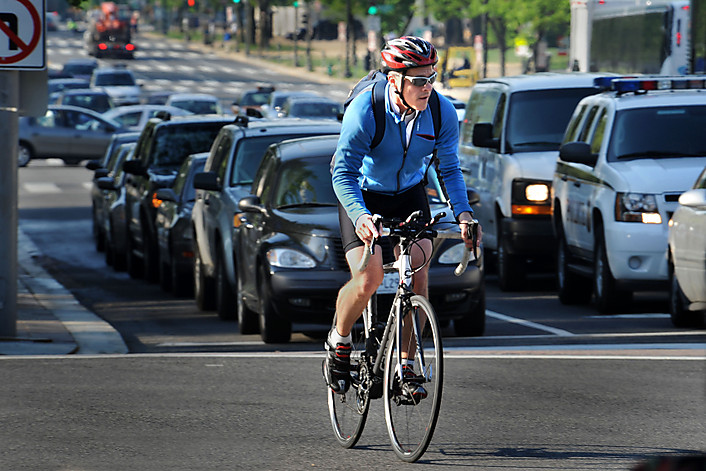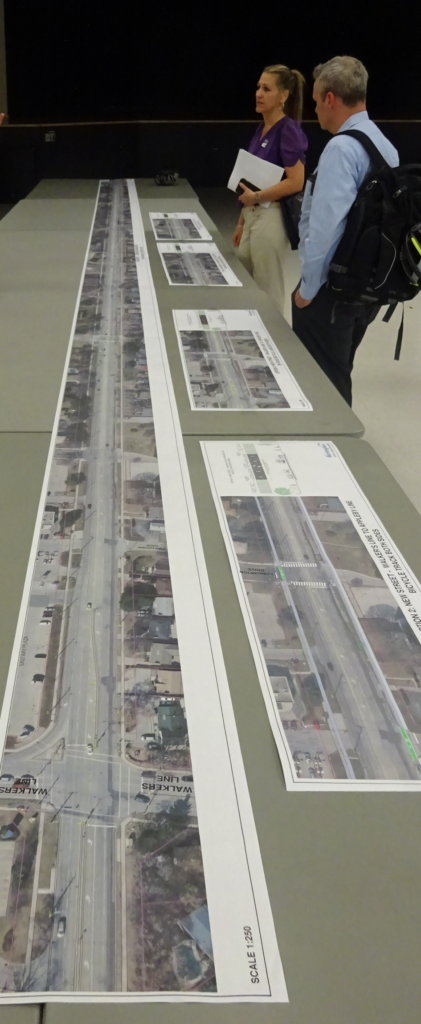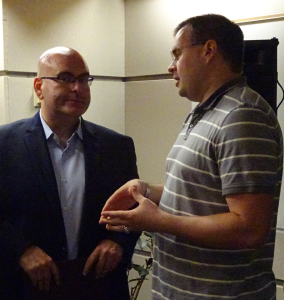 By Greg Woodruff
By Greg Woodruff
September 23, 2016
BURLINGTON, ON
Having run for the office of Regional Chair in the last municipal election I’ll tell you the best part of an election campaign is talking to people. You get a really good idea of who is engaging with the municipal government and what they are on about. For the purpose of understanding the points of view here I’m going to grotesquely lump people into two camps; the “car” faction and the “bike” faction.
The car faction focuses on the incredible cost of housing, property tax and commute time they expend every day to live in Burlington. Commute time is adding to already full schedules and placing all sorts of pressure on them and their family. The commute time is stealing time with their kids, spouses, exercise, cooking dinner or just time to relax (if any exists) every day. Since the same problem afflicts half of the people in Burlington, would you not expect government at all levels should be primarily focused on cutting down this complete waste of time and resources? They believe in essence that the focus of government is to solve the problems of the citizens.

SLUG: ph-cyclists DATE: April 15, 2010 NEG NUMBER: 213218 LOCATION: Constitution Avenue, NW at New Jersey and 6th streets intersections. PHOTOGRAPHER: GERALD MARTINEAU, for TWP CAPTION: We photograph morning rush hour bicycle commuters amidst traffic on Constitution Avenue, NW. Photo shot at Constutution Ave, NW. and 6th Street. StaffPhoto imported to Merlin on Thu Apr 15 11:19:04 2010
Then there is the bike faction. Currently the amount of resources being used on the planet per year would require 1.6 earths of space to sustain this level of resource use indefinitely. If you could catapult every human to the standard of living of a Canadian then you would need 4.7 earths. If you don’t bring the level of resource consumption to one, then it’s some sort of displacement mixed with brutal starvation for a large numbers of people somewhere on the planet. They believe in essence that the focus of the government should be to limit resource consumption.
Enter car vs bike. The car faction is trying to get around as quickly as possible in a city that was never designed for anything else. The bike faction is trying to get everyone to bike, because it’s got a favourable energy profile compared to cars. Enter the New Street “road diet” where you take lanes of traffic away. After the one year of study the outcome will be – drum roll – some increase in the number of people biking and some increase in the time it takes to drive down New Street.
The car faction will declare the whole thing as idiotic as minimizing travel time is their priority. How can it possibly make sense to delay thousands of people for a handful of bikers? The bike faction will declare the whole thing as a success, because no matter how minimal the increase in biking – it’s an increase. A part of the second faction will even like the creation of snarled traffic – this more extreme position seeks to reduce car use by making it as unpleasant as possible.
So how to get out of this mess? In my opinion goal number one is; don’t set these groups against each other. If you do the municipal government just endlessly swings from one camp to the other trying to seek some sort of peace. When traffic becomes hopelessly snarled beyond human endurance – then large numbers of people will descend on city hall and something will be done about it. Lanes of traffic will be added, though now awkwardly. When it’s manageable all sorts of groups bombard council with low cost utopian ideas of how to get people off the roads.

Proposed bike lanes being shown at a public meeting – the city went for a lane on either side of New Street from Walkers Line to Guelph Line for a one year trial period.
For biking my preferred plan is still a 10 foot wide “roller path” with two oncoming 5 foot lanes for bike travel separated from the road. The best part of this plan is users get to live. Bikes on the pavement with cars exposes bikers to unnecessary risk. Spending money on such a path makes no financial sense as a method of transportation, but it’s an asset to the community. Even if you have no ability or inclination to bike, you still want best in class bike lanes because it splits the second faction in two. You will separate out the people who just want better bike access from the people who want the road system generally degraded. Right now the two groups are aligned.
I see nothing in the current direction of Burlington that will not increase car dependency in the future. The distances in Burlington are impractical for walking, buses get snarled in traffic and the Official Plan puts localized mass transit densities off the table. Our new habit of knocking down most commercial space in the southern part of the city for condos and building large commercial blocks in the north cements car use like never before. We are not moving away from the “subdivision”. We have just invented a high density/parkless/treeless version of it. New developments are not designed to make a nice place to live, just warehouse people as cheaply as possible.
What I am completely against is the government engineering a place where you are free to have a car, but the government tries to make it practically impossible to use it. At the core, that is what most of these new schemes are about. I’m all for best in class bike lanes and giving people that want to bike a safe place to do so. However, if it’s impractical, impossible or just unpleasant for people to bike and they decide to drive it’s the government’s job to accommodate them as well.

Greg Woodruff, on the right, in conversation with the Minister of Transit.
Greg Woodruff is a resident of Aldershot who works in the information technology industry. He ran for the office of Regional Chair in the 2014 election and is a frequent commentator on local public affairs.



















I agree with Steve and with Phillip Wooster.
Burlington is NOT Vancouver, obviously, and needs a made-in-Burlington plan for transportation. The comments attributed to Brent Toderian that I have seen are so lame and lacking substance that I’m surprised anyone would take him seriously.
A point that I haven’t seen raised: roads are normally built with expensive foundations to accommodate trucks, cars, emergency vehicles, etc. Taking away road space for light vehicles (like bicycles) that need only a few inches of cheap asphalt to ride on seems like very poor economics. Let’s stop ignoring the realities.
Time for the silent majority to wake up and vote out these politicians who pander to the tiny amount of bicyclists, at the expense, of the vast majority of drivers.
Hopefully, the attempt at choking traffic (road diet, gotta luv it folks) for a handful of bikes will wake people up, and they will vote accordingly.
Steve, you have to ask why the City sponsors/funds a special interest lobby group–the Cycling Committee–a group dominated by the hobbyists–the Lycra Road Warriors. At best, cyclists represent no more than .5% of all road users on an annualized daily basis. Its effective lobbying runs contrary to the interests of the other 99.5% of all road users. The Cycling Lobby continues to frame the debate–quite dishonestly as a transportation issue–it isn’t! It’s about their hobby and they want us to pay for it.
Burlington is a commuter town; some 70%+ of all breadwinners earn their living outside of Burlington. The car is still the most TIME-EFFICIENT method of transportation that we have into the foreseeable future. It is still the most time-efficient method of travel within Burlington, given Burlington’s geography.
Cycling & walking are never going to make an impact–even small, on the transportation issues facing this town. And understand that TIME is the most valuable commodity on the commuter’s list; they will never pursue a transportation method that is less efficient.
Meanwhile, the empty-suit in the mayor’s chair continues to trot out Brent Toderian, a greenie “ex-spurt” (fired by the City of Vancouver) at a cost not disclosed to we taxpayers–a group ignored by the mayor & this council. The mayor needs this ex-spurt to validate his stupidity on the transportation file.
Editor’s note:
While the Mayor is relatively new to Toderian – he is well known by both our current planner and the current city manager so whatever flaws he may have they are well known. It is not unusual for a planner and a city council and its mayor to see things differently. Our last planner didn’t open the door to leave – he was shown the door – that’s just part of life at the municipal level.
As the cycling committee member involved in this debate and as someone who has maybe worn Lycra twice in my 17 years in Burlington, your continued campaign to portray a group of community members who volunteer their time and energy to running events and supporting a safer community as a Lobby group for the .5% is nothing short of rude and obnoxious politicizing. Have you ever attended a meeting of the Burlington Cycling Committee? Do you actually know any of the members? Your ignorance when it comes to the Cycling Committee, our role as an advisor on Cycling matters, the work we do and the people involved is quite evident.
You, Philip Wooster, if that is your real name and the one you posted this same lame attempt to discredit my arguments on Councillor Meed Ward’s site (Phil Waggett) is a false one, are the person who is being dishonest.
Touched a nerve, did it? The issue isn’t New Street, it’s the role of your lobby group (and that’s what it is) funded by the City. By the way, I’ve heard from some “seniors” who cycle–they used to be involved with the Cycling Committee, although not part of it–they are the ones who exposed your group for what it really is.
As far as that economic activity goes…you will recall last time there was a mild recession our governments had to bail out the major auto manufacturers with billions of tax dollars. There may be some local impacts but the majority of the money spent on automobiles flows outside of the local economy.
It’s also true that a lot of jobs exist to deal with the outcome car dependence creates. With fewer cars on the road we wouldn’t need to employ as many EMTs and firefighters.
However, even from your experience, your family members in Holland obviously are well-off enough to afford automobiles (which are considerably more expensive to operate in that country than they are here), This proves that as we transition to a more balanced transportation system, it need not kill off the economy.
Ford for one has seen the writing on the wall – they are investing in carshare and bikeshare. The future of their business is not just about cars, but about mobility.
https://www.theverge.com/2016/9/9/12861632/ford-shuttle-bus-bikeshare-chariot-motivate-san-francisco
‘Anyone who thinks that Holland is such a great place to drive a car has obviously never been stuck in its traffic jams.”
The people who think Holland is the best place to drive a car are the people who drive cars there on a regular basis. Here is a link the full report: https://inbox-static.waze.com/driverindex.pdf
Not saying they never have traffic jams, but could you imagine the traffic jams they would have in the cities if 23% of trips in the cities were not taken by bicycle?
It would be prudent to be careful about what some might wish for; i.e., a grand shift from cars to bicycles. That second car, which many families have, probably creates more stimulus to the local economy than an equivalent amount to its cost being spent elsewhere, such as on travel. Cars have been the foundation and fuel for the north American economy for nearly a century. Local car dealers, repair shops, tire sales outlets, paving companies, etc. need the business to remain viable and employ many of our fellow citizens. If car sales fall low enough, would it be a surprise if most of the remaining Ontario automobile manufacturers (Ford, Chrysler, GM, Honda, Toyota) simply closed their factories and became importers? Would Hamilton still need to produce any steel at all? Will an increase in bicycle manufacturing replace the lost economic activity? Or will bicycles be imported from China, like everything else?
Anyone who thinks that Holland is such a great place to drive a car has obviously never been stuck in its traffic jams. The distances are shorter but traffic congestion is similar. I have a large number of family members there (I visit regularly) and they all have cars, for the same reasons as Canadians: car ownership improves the quality of life for most people.
Some good seeds for conversation here in this opinion piece. I agree that whole “car vs. bike” paradigm is not at all helpful.
We can’t ignore the fact that the benefit of having fewer cars on the road largely go to the people who drive cars. Fewer people driving means less time spent by commuters in traffic. It also makes the alternatives to driving more feasible (biking and walking become safer and more attractive, buses don’t get stuck in traffic), so as a result fewer people have to drive. A virtuous cycle, in contrast to the vicious cycle we have now where increasing traffic makes life more difficult for drivers, cyclists and pedestrians alike.
As Brent Toderian highlighted in his presentation to Council, “if you design a city for cars, it fails for everyone, including drivers. If you design a multi-modal city that prioritizes walking, biking and public transport, it works for everyone, including drivers.”
Therefore, it shouldn’t be a surprise to anyone that the country voted the best by drivers for stress-free commuting and goods movement, is the Netherlands.
https://dailyhive.com/vancouver/best-place-in-the-world-to-be-a-driver-netherlands
Here in Canada, we’ve been locked into this paradigm of more cars, more roads, more taxes for at least the past 60 years. This is “social engineering” at work. We’ve spent immense amounts of resources in the drive to more speed for motorists, and most of that spending has been wasted. Not only that, but we have imposed tremendous costs on society in the process – high rates of accidents & deaths, the policing resources needed to enforce the rules of the road, increasing obesity rates and health impacts, pollution…the list goes on and on. The free and open roads in the car commercials are a mirage that never reflects our day to day experience. And the truth for most of us is we don’t even use our cars 99% of the day. It just sits there depreciating from the day we drive off the dealer’s lot.
Meanwhile road spending is out of control. Last year council authorized an extra $20 million over 4 years, that’s in addition to a $300 million budget at the City (excluding Regional roads) over the next 10 years. And despite all that spending, there’s still a backlog – we probably need to spend double just to catch up with needed maintenance. More cars and trucks means more wear and tear, and even greater costs that someone (most likely the property taxpayers) will have to pony up.
As far as New Street goes, the author seems to believe that there will be “delays for thousands of people for a handful of bikers”. Again, we’ve yet to see evidence that motorists travel times will be impacted, and have yet to quantify what the impact is – does it add 5 seconds, 10 seconds, 5 minutes to the rush hour commute? The pilot project should help us answer those questions. It should also tell us if there are other benefits – reduced speeding, cut-through traffic from the QEW, fewer accidents. Was 4 lanes of traffic ever necessary in that location in the first place? Other cities that have done road diets on even busier roads than New Street reported little or no increase in travel times.
What I do not expect from the pilot is a substantial increase in the number of bicycles in the short term. After all, it’s just one segment of one street. Think of all the trips you take in the average week – how many would be possible on only a 2km section of one street? It takes a complete network to move forward like Vancouver has, we are just starting and many gaps still remain.
It also offers only paint as protection, which does little to encourage novice cyclists, women, children, seniors, etc. to make more of their regular trips by bicycle. At least the buffer provides space where a physical buffer can be added in future. There’s merit in the idea of a separated cycle track, but also concerns (i.e. intersections) about safety, in addition to the significant cost.
I applaud Mr. Woodruff for raising the environmental issue, probably the most critical of all. While today we enjoy the freedom of choice, the choices being made here and elsewhere have led to challenges which threaten the very survival of our species and within our childrens’ lifetimes. The math on global warming is not in our favour.
https://newrepublic.com/article/136987/recalculating-climate-math
If we’re going to have a hope of meeting our vast financial and environmental challenges, we have to take more than token steps to reverse the vicious cycle that engineering car-dependence has created for us.
Choosing to bike instead of drive, if you can, is one of the best ways to have a positive impact. Not only does it support better health and better productivity at work, but it also saves a good deal of money. Every family that can do without a second car would save on average $10K per year, which is equivalent to a $15K/year raise before taxes. Imagine the benefits of just 5% of the households in the city doing this. That’s an additional $35 million a year in Burlington citizens’ pockets, which can circulate in the local economy, supporting more jobs and economic growth close to home, instead of flowing elsewhere in the form of gasoline, insurance and car payments.
It is essential that the city do all that it can to maximize the benefits of cycling. Not just for the benefit of cyclists, but for the benefit of drivers, pedestrians and taxpaying citizens, as well as for the benefit of our kids’ future.
Editor’s note: Seeing a reference to the “New Republic” in a comment warms my heart. The purpose of a comment is to inform the debate – that certainly happens with this one. That doesn’t necessarily mean I agree with the writer. It is the quality of the argument that impresses me.
Great article Greg with some original and unique insights. Your pragmatism and common sense is refreshing…makes me glad I voted for you for Regional Chair in 2014.
I hope you decide to run for Council next municipal election. Given the apparent dissatisfaction with developments in Ward 1 I would suggest that as a possible option.
Greg – Interesting view of how transportation modes relate to each other.
On Tuesday the Committee of the Whole met and had a 3 hour workshop on transportation. Their perspective are far more diverse than what you have considered here. Walking, cycling, transit and car use were discussed with ideas from adding sidewalks to closing the QEW and making it into a park.
A video of the meeting is available on the city site,it’s worth a look for anyone interested in the future of transportation in Burlington.